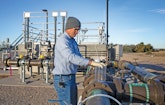
Paul Jager of the Marana Water Department flushes a fire hydrant at the Tangerine Business Park in Marana, Arizona.
(Photography by Mark Henle)
Few communities in America are more conscious of their water supply than Marana, Arizona.
Located a few miles northwest of Tucson along Interstate 10, Marana relies on Colorado River water through the Central Arizona Project (CAP), groundwater and reclaimed wastewater to deliver a...







